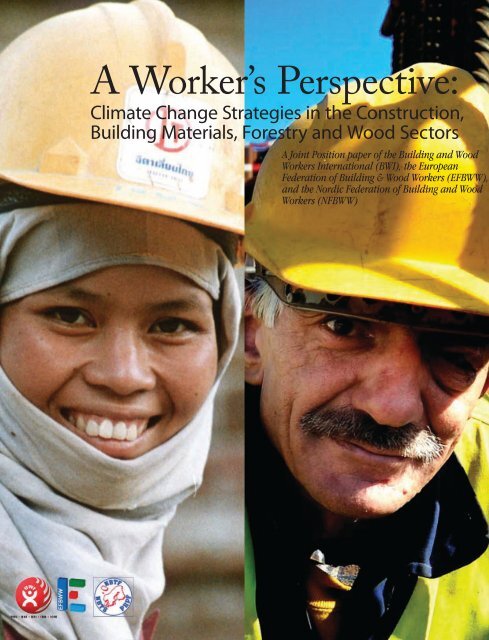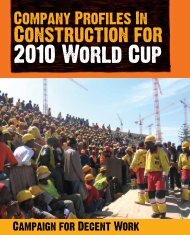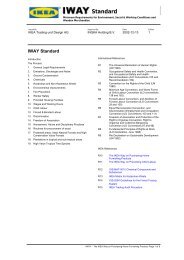A Worker's Perspective: Climate Change Strategies in the ... - bwint.org
A Worker's Perspective: Climate Change Strategies in the ... - bwint.org
A Worker's Perspective: Climate Change Strategies in the ... - bwint.org
You also want an ePaper? Increase the reach of your titles
YUMPU automatically turns print PDFs into web optimized ePapers that Google loves.
A Worker’s <strong>Perspective</strong>:<br />
<strong>Climate</strong> <strong>Change</strong> <strong>Strategies</strong> <strong>in</strong> <strong>the</strong> Construction,<br />
Build<strong>in</strong>g Materials, Forestry and Wood Sectors<br />
A Jo<strong>in</strong>t Position paper of <strong>the</strong> Build<strong>in</strong>g and Wood<br />
Workers International (BWI), <strong>the</strong> European<br />
Federation of Build<strong>in</strong>g & Wood Workers (EFBWW),<br />
and <strong>the</strong> Nordic Federation of Build<strong>in</strong>g and Wood<br />
Workers (NFBWW)<br />
1
Introduction<br />
The impacts of climate change are not<br />
evenly distributed - <strong>the</strong> poorest countries<br />
and people will suffer earliest and most.<br />
And if and when <strong>the</strong> damages appear<br />
it will be too late to reverse <strong>the</strong> process.<br />
Thus we are forced to look a long way<br />
ahead.<br />
The Stern review, Executive Summary Page vii<br />
<strong>Climate</strong> change affects all of us, not only as consumers but also as<br />
workers. The construction, build<strong>in</strong>g materials, forestry, and wood<br />
<strong>in</strong>dustry, employ<strong>in</strong>g around 200 million workers, play an important<br />
role <strong>in</strong> contribut<strong>in</strong>g to and reduc<strong>in</strong>g CO2 emissions. Deforestation<br />
is <strong>the</strong> second largest source of carbon <strong>in</strong> <strong>the</strong> atmosphere. Build<strong>in</strong>gs<br />
are responsible for about 8% of global CO2 emissions and <strong>the</strong>ir use<br />
<strong>in</strong>creases <strong>the</strong>ir contribution upwards of 40%. 1 However, without any<br />
doubt, <strong>the</strong> construction and wood <strong>in</strong>dustry can deliver a substantial<br />
contribution to <strong>the</strong> reduction of greenhouse gases and <strong>the</strong> problem of<br />
global warm<strong>in</strong>g. We are part of <strong>the</strong> solution.<br />
<strong>Climate</strong> change, which is considered to be one of <strong>the</strong> most threaten<strong>in</strong>g<br />
environmental problems of <strong>the</strong> 21st centruy affects all of us, as<br />
consumers and as workers. Accord<strong>in</strong>g to <strong>the</strong> United Nations<br />
Framework Convention on <strong>Climate</strong> <strong>Change</strong> (UNFCCC), climate<br />
change “may be attributed directly or <strong>in</strong>directly to human activity”<br />
which changes <strong>the</strong> composition of <strong>the</strong> atmosphere <strong>in</strong> addition to <strong>the</strong><br />
natural climate changes <strong>in</strong> certa<strong>in</strong> periods. Adopted <strong>in</strong> March 1994, <strong>the</strong><br />
UNFCCC gives <strong>the</strong> global framework for governments to tackle <strong>the</strong><br />
challenge posed by climate change. To date, 192 countries have ratified<br />
this convention.<br />
Poverty is a primary contributor to global deforestation, which is one<br />
of <strong>the</strong> largest contributors to carbon <strong>in</strong>crease <strong>in</strong> <strong>the</strong> environment.<br />
Construction is <strong>in</strong>creas<strong>in</strong>gly tak<strong>in</strong>g place <strong>in</strong> develop<strong>in</strong>g countries,<br />
where most of <strong>the</strong> world’s fastest grow<strong>in</strong>g large cities are located. The<br />
construction <strong>in</strong>dustry makes huge demands on global natural resources,<br />
and this assumes great environmental significance with <strong>the</strong> rapid, and<br />
accelerat<strong>in</strong>g, growth <strong>in</strong> <strong>the</strong> global population. It is imperative that <strong>the</strong><br />
demands on global natural resources are balanced with <strong>the</strong> ‘carry<strong>in</strong>g<br />
capacity’ of <strong>the</strong> physical environment.<br />
2<br />
1 Forestry and climate change graphics used with permission from <strong>the</strong><br />
United K<strong>in</strong>gdom Forestry Commission
This paper focuses on CO2 emissions and CO2 conta<strong>in</strong>ment <strong>in</strong><br />
connection to employment, job creation, and decent work. How do we<br />
ensure that workers, whose livelihoods depend on a job <strong>in</strong> a chang<strong>in</strong>g<br />
sector, still benefit from decent work and receive <strong>the</strong> tra<strong>in</strong><strong>in</strong>g <strong>the</strong>y need<br />
to make <strong>the</strong> transition? We have two ma<strong>in</strong> po<strong>in</strong>ts: (1) Upgrad<strong>in</strong>g energy<br />
efficiency <strong>in</strong> construction and energy renovation of exist<strong>in</strong>g build<strong>in</strong>gs;<br />
and (2) Reforestation and susta<strong>in</strong>able forest management<br />
CURRENT POLICY PROPOSALS<br />
Driven by nations with market-based economies, <strong>the</strong> current debate<br />
focuses primarily on design<strong>in</strong>g a market mechanism to establish a<br />
monetary price for carbon pollution. By putt<strong>in</strong>g a price on carbon<br />
pollution, <strong>the</strong> th<strong>in</strong>k<strong>in</strong>g is that carbon polluters will not be able to<br />
externalize <strong>the</strong>ir costs onto <strong>the</strong> public <strong>in</strong> general and onto those without<br />
voice or without political power.<br />
It is important that policies be designed so that markets, if relied upon<br />
for carbon pollution abatement, are effectively and efficiently regulated.<br />
Monies raised from carbon trad<strong>in</strong>g or taxes must be dedicated to<br />
promot<strong>in</strong>g social justice with a specific emphasis on poverty reduction,<br />
and worker re-adjustment tra<strong>in</strong><strong>in</strong>g for those displaced by <strong>the</strong> lower<br />
carbon economy.<br />
Construction, Build<strong>in</strong>g Materials and<br />
Aspects of <strong>Climate</strong> <strong>Change</strong><br />
Before <strong>the</strong> advent of <strong>the</strong> <strong>in</strong>tegrated global economy dom<strong>in</strong>ated by<br />
<strong>in</strong>ternational construction companies, build<strong>in</strong>gs were constructed<br />
with regard to <strong>the</strong> surround<strong>in</strong>g environment. For example if wea<strong>the</strong>r<br />
extremes were an issue walls would be built thicker or th<strong>in</strong>ner. Today<br />
we tend to build <strong>the</strong> same build<strong>in</strong>gs regardless of local conditions. Such<br />
build<strong>in</strong>gs tend to have larger carbon footpr<strong>in</strong>ts.<br />
If we were once aga<strong>in</strong> to build based on <strong>the</strong> needs of local populations<br />
and local conditions <strong>the</strong> carbon footpr<strong>in</strong>t of build<strong>in</strong>gs could be<br />
significantly reduced. By plac<strong>in</strong>g <strong>the</strong> design and construction of<br />
build<strong>in</strong>gs back <strong>in</strong>to local cultural and environmental contexts we<br />
would also create opportunities to use and support local skills and local<br />
build<strong>in</strong>g materials <strong>the</strong>reby re<strong>in</strong>forc<strong>in</strong>g social susta<strong>in</strong>ability as well as<br />
environmental and economic susta<strong>in</strong>ability.<br />
larger groups of procurers of goods and services, governments need<br />
to set rigorous standards for new construction, retrofitt<strong>in</strong>g targets for<br />
exist<strong>in</strong>g build<strong>in</strong>gs, and support <strong>in</strong>novative design and construction<br />
processes through <strong>the</strong>ir public procurement processes.<br />
The development of build<strong>in</strong>g codes that encourage and support central<br />
heat<strong>in</strong>g/cool<strong>in</strong>g and o<strong>the</strong>r carbon reduction technologies can play an<br />
important role. Governments can establish <strong>in</strong>centives to encourage <strong>the</strong><br />
private sector to engage <strong>in</strong> energy renovation schemes.<br />
B. BUILDING MATERIALS AND CARBON:<br />
1. Wood<br />
Wood is a unique material <strong>in</strong> that <strong>the</strong> CO2-emission from burn<strong>in</strong>g<br />
wood is identical to <strong>the</strong> CO2 be<strong>in</strong>g absorbed dur<strong>in</strong>g growth. Wood<br />
<strong>the</strong>refore is CO2-neutral and timber as a build<strong>in</strong>g material stores carbon<br />
for <strong>the</strong> length of its use. In many cases, for centuries.<br />
In <strong>the</strong> global south, <strong>the</strong> pressure to be both “western” and “modern”<br />
<strong>in</strong> our built environment is a major contributor to build<strong>in</strong>gs with<br />
higher carbon footpr<strong>in</strong>ts rely<strong>in</strong>g on technologies and expertise that<br />
must be imported. This is particularly challeng<strong>in</strong>g <strong>in</strong> <strong>in</strong>frastructure<br />
development. In geographic areas suffer<strong>in</strong>g from <strong>in</strong>adequate<br />
<strong>in</strong>frastructure, <strong>the</strong> current construction market can deliver ‘western<br />
styled” high carbon footpr<strong>in</strong>t solutions far more cheaply than lower<br />
carbon options, especially when cost is considered over a shorter time<br />
horizon.<br />
A. THE ROLE OF BUILDINGS IN REDUCING EMISSIONS<br />
Governments must play a more direct role as a driv<strong>in</strong>g force for lower<br />
carbon construction design, construction and use. Through <strong>the</strong>ir<br />
political power as regulators and <strong>the</strong>ir economic power as one of <strong>the</strong><br />
Every cubic meter of wood used as a substitute for o<strong>the</strong>r build<strong>in</strong>g<br />
materials reduces CO2-emissions to <strong>the</strong> atmosphere by an average of<br />
1.1 t CO2 2 . Added to <strong>the</strong> 1 t of CO2 stored <strong>in</strong> wood, each cubic meter<br />
of wood that is substituted for o<strong>the</strong>r build<strong>in</strong>g materials saves a total of<br />
2.1 t CO2. Based on <strong>the</strong>se figures, a 10% <strong>in</strong>crease <strong>in</strong> <strong>the</strong> percentage of<br />
timber houses <strong>in</strong> Europe alone would produce sufficient CO2 sav<strong>in</strong>gs<br />
to account for about 25% of <strong>the</strong> reductions prescribed by <strong>the</strong> Kyoto<br />
Protocol 3 .<br />
Us<strong>in</strong>g wood saves energy over <strong>the</strong> life of a build<strong>in</strong>g, as its cellular<br />
structure provides <strong>the</strong>rmal <strong>in</strong>sulation, and is becom<strong>in</strong>g an ever more<br />
competitive solution <strong>in</strong> “green” build<strong>in</strong>g regulations.<br />
2 “Tackle <strong>Climate</strong> <strong>Change</strong>. Use wood”, Cei-Bois, November 2006.<br />
3 “Tackle <strong>Climate</strong> <strong>Change</strong>. Use wood”, Cei-Bois, November 2006.<br />
3
2. Cement<br />
Cement production is a significant source of greenhouse gas (GHG)<br />
emissions. Virtually all <strong>the</strong> cement <strong>in</strong>dustry’s output is used <strong>in</strong> <strong>the</strong><br />
construction sector, especially for concrete, which is used as a material<br />
<strong>in</strong> quantities second only to our use of water. Twice as much concrete is<br />
used worldwide as <strong>the</strong> total of all o<strong>the</strong>r build<strong>in</strong>g materials put toge<strong>the</strong>r.<br />
Concrete conta<strong>in</strong>s 10 – 15% cement. As much as 1.25 tonnes of CO2 is<br />
produced for every tonne of cement, and around 1600 kg of raw material<br />
is needed to produce 1000 kg cement. Globally, 2.6 billion tonnes of<br />
cement are produced each year and, based on current trends, CO2<br />
emissions from <strong>the</strong> cement <strong>in</strong>dustry will quadruple by 2050. 4<br />
The manufacture of Portland cement (PC) is one of <strong>the</strong> most energy<br />
<strong>in</strong>tensive of all <strong>in</strong>dustrial manufactur<strong>in</strong>g processes and is responsible for<br />
up to 10% of man-made CO2 emissions worldwide. Portland Cement<br />
(PC) is <strong>the</strong> most widely consumed cement variety worldwide. PC is<br />
a major constituent <strong>in</strong> <strong>the</strong> manufacture of a wide range of build<strong>in</strong>g<br />
materials and construction products <strong>in</strong>clud<strong>in</strong>g structural and nonstructural<br />
concretes (of which more than 5 billion tonnes are produced<br />
globally each year), <strong>in</strong>clud<strong>in</strong>g mortars, slabs, pav<strong>in</strong>g blocks and<br />
foundations. These materials make up a vital part of our <strong>in</strong>frastructure<br />
but <strong>the</strong> production processes of cement and cement products result <strong>in</strong> a<br />
tremendous environmental impact.<br />
The global cement <strong>in</strong>dustry is <strong>in</strong>vest<strong>in</strong>g <strong>in</strong> research and development<br />
to f<strong>in</strong>d ways to reduce its emission of GHGs, ma<strong>in</strong>ly through reduc<strong>in</strong>g<br />
its use of fossil fuels. It is essential to establish a level play<strong>in</strong>g field on<br />
regulations and emissions for <strong>the</strong> cement <strong>in</strong>dustry to ensure that this<br />
4 A Concrete Foundation. In: Tomorrow, 12:6, December 2002.<br />
sector can contribute to reductions <strong>in</strong> green house gases. Recycl<strong>in</strong>g and reuse<br />
of concrete must be encouraged.<br />
C. PUBLIC PROCUREMENT<br />
Regulations govern<strong>in</strong>g public procurement aim to guarantee fair and<br />
transparent competition to obta<strong>in</strong> <strong>the</strong> best quality-price ratio with<br />
optimum use of public funds. Policy considerations on social and<br />
environmental aspects of build<strong>in</strong>g and construction, important as <strong>the</strong>y<br />
may be, are not usually a factor <strong>in</strong> decisions concern<strong>in</strong>g <strong>the</strong> award of<br />
procurement contracts at this time.<br />
Public projects can require bidders to:<br />
• use state of <strong>the</strong> art carbon reduction design and construction elements.<br />
• give preferences to <strong>the</strong> lowest carbon footpr<strong>in</strong>t bid based on <strong>the</strong> price of<br />
carbon ei<strong>the</strong>r sequestered or avoided<br />
• require <strong>the</strong> use of certified products where systems are <strong>in</strong> place such as<br />
<strong>in</strong> <strong>the</strong> case of forest certification<br />
• ensure that social criteria that <strong>in</strong>centivize decent work, safe work and<br />
work that honors <strong>the</strong> ILO core labor standards are mandated <strong>in</strong> bids.<br />
European legislation already accepts that susta<strong>in</strong>able development,<br />
<strong>in</strong>clud<strong>in</strong>g susta<strong>in</strong>able forest management, can be used as an award criterion<br />
<strong>in</strong> award<strong>in</strong>g contracts. In fact <strong>the</strong>re is a long history of procurement polices<br />
be<strong>in</strong>g used to advance social justice <strong>in</strong> areas such as: employment policies,<br />
apprenticeships and skills tra<strong>in</strong><strong>in</strong>g, wages, work<strong>in</strong>g hours, health and<br />
safety, child labour, forced labor, tropical timber, and many o<strong>the</strong>rs. Public<br />
authorities can opt for a wide array of susta<strong>in</strong>able public procurement<br />
options as long as <strong>the</strong>y do not discrim<strong>in</strong>ate based on nationality.<br />
Governments must <strong>in</strong>troduce environmental and social clauses <strong>in</strong> all<br />
tender documents for public works.<br />
4
D. TECHNOLOGY AND INVESTMENTS IN RENEWABLE ENERGY<br />
Technologies are already available to avoid a carbon <strong>in</strong>tensive future but <strong>the</strong>y need to be deployed on a wider<br />
scale. Factors such as <strong>the</strong>ir cost, current low levels of deployment, <strong>the</strong> restrictive application of patents and<br />
lack of political will are responsible for <strong>the</strong> poor diffusion of technological <strong>in</strong>novations. Governments as well<br />
as companies must <strong>in</strong>crease efforts <strong>in</strong> research and development <strong>in</strong> <strong>the</strong> construction sector and on renewable<br />
energy, renewable materials and energy efficient facilities management.<br />
Recently <strong>the</strong> Centre for European Policy Studies (CEPS) (Brussels 2009) demonstrated that <strong>the</strong><br />
construction <strong>in</strong>dustry has one of <strong>the</strong> lowest <strong>in</strong>vestments <strong>in</strong> research and development (0.1%). Major<br />
companies tend to be more <strong>in</strong>novative than small and medium sized companies – a serious problem, s<strong>in</strong>ce<br />
90% of construction companies world wide are micro enterprises, employ<strong>in</strong>g less than ten workers. A key<br />
<strong>in</strong>strument to boost <strong>the</strong> “quality of labour” and productivity would be sizeable <strong>in</strong>vestments <strong>in</strong> <strong>the</strong> vocational<br />
and professional tra<strong>in</strong><strong>in</strong>g of workers.<br />
E. CENTRAL HEATING - CENTRAL COOLING<br />
In cold countries, most energy spent <strong>in</strong> <strong>the</strong> build<strong>in</strong>g is for heat<strong>in</strong>g. Homes’ CO2 releases are one of <strong>the</strong> most<br />
important causes of <strong>the</strong> “greenhouse effect”. To reduce <strong>the</strong> energy used <strong>in</strong> heat<strong>in</strong>g, <strong>the</strong> build<strong>in</strong>gs are typically<br />
<strong>in</strong>sulated. In hot countries, most energy spent <strong>in</strong> <strong>the</strong> build<strong>in</strong>g is for cool<strong>in</strong>g. When <strong>in</strong>sulat<strong>in</strong>g <strong>the</strong>se build<strong>in</strong>gs<br />
you can get <strong>the</strong> same effect as when you <strong>in</strong>sulate to keep <strong>the</strong> cold out. You can keep <strong>the</strong> warm air <strong>in</strong>side<br />
warm, or keep <strong>the</strong> cool air <strong>in</strong>side cool. The most energy efficient way to heat a house is central heat<strong>in</strong>g, and<br />
this technique can also be used <strong>in</strong> central cool<strong>in</strong>g. In Copenhagen experiments have already begun <strong>in</strong> this<br />
area.<br />
F. INCENTIVES FOR BUILDING OWNERS TO REDUCE ENERGY USE<br />
The owner of <strong>the</strong> build<strong>in</strong>g will also benefit economically from renovat<strong>in</strong>g <strong>the</strong> build<strong>in</strong>g, sav<strong>in</strong>g money<br />
o<strong>the</strong>rwise spent on energy. This is big <strong>in</strong>centive for <strong>the</strong> owners whe<strong>the</strong>r private, companies or governments.<br />
Governments should establish appropriate motivation mechanisms and <strong>in</strong>centives to encourage <strong>the</strong> private<br />
sector to engage <strong>in</strong> energy renovation schemes.<br />
Forests and Environmental Aspects of <strong>Climate</strong> <strong>Change</strong><br />
Forests contribute to carbon storage. On average a typical tree absorbs, through photosyn<strong>the</strong>sis, <strong>the</strong><br />
equivalent of 1 ton of carbon dioxide for every cubic meter of growth, while produc<strong>in</strong>g <strong>the</strong> equivalent of<br />
0.7 t of oxygen 5 . This fiber cont<strong>in</strong>ues to store carbon until released most frequently through fire and soil<br />
disruption result<strong>in</strong>g from natural disturbances, land use change, and harvest<strong>in</strong>g activity.<br />
EXAMPLES FROM EUROPE<br />
In France <strong>the</strong> parliament has decided<br />
to double <strong>the</strong> number of old build<strong>in</strong>gs<br />
<strong>the</strong>y will energy-renovate, <strong>the</strong>reby<br />
<strong>in</strong>creas<strong>in</strong>g <strong>the</strong> number of renovated<br />
build<strong>in</strong>gs to 400.000 yearly. The<br />
program will start with 800.000 public<br />
build<strong>in</strong>gs that will be energy-renovated<br />
by <strong>the</strong> end of 2015.<br />
In Germany <strong>the</strong> CO2<br />
Gebäudesanierungsprogramm targets<br />
a yearly energy-renovat<strong>in</strong>g of 5% of all<br />
build<strong>in</strong>gs from before 1978. This has<br />
created 190.000 jobs, saved 2 million<br />
tons of CO2 emissions and reduced<br />
heat<strong>in</strong>g bills.<br />
In <strong>the</strong> Ne<strong>the</strong>rlands <strong>the</strong> government<br />
has approved plans on energyrenovat<strong>in</strong>g<br />
<strong>in</strong> 200.000 - 300.000<br />
build<strong>in</strong>gs a year.<br />
In a number of countries <strong>in</strong>clud<strong>in</strong>g<br />
those cited above and <strong>the</strong> UK,<br />
governments have decided to<br />
<strong>in</strong>troduce targets for energy effective<br />
build<strong>in</strong>g of new build<strong>in</strong>gs. These<br />
demands will be <strong>in</strong>troduced <strong>in</strong><br />
<strong>the</strong> period 2012-2015. CO2 neutral<br />
houses will be obligatory <strong>in</strong> <strong>the</strong> UK<br />
from <strong>the</strong> year 2016 and <strong>in</strong> France, <strong>the</strong><br />
Ne<strong>the</strong>rlands and Germany from <strong>the</strong><br />
year 2020.<br />
In order for <strong>the</strong> carbon sequestration benefits of forests to be maximized, a number of conditions must be<br />
met. Most importantly, forest management must respect <strong>in</strong>ternationally agreed pr<strong>in</strong>ciples of susta<strong>in</strong>able<br />
forest management. When forests are managed susta<strong>in</strong>ably, carbon releases from natural disturbances are<br />
m<strong>in</strong>imized, carbon neutral or nearly neutral consumer goods are produced and <strong>the</strong> long-term health of <strong>the</strong><br />
forests is <strong>in</strong>tegrated <strong>in</strong>to <strong>the</strong> long-term management plan.<br />
The Food and Agriculture Organization (FAO) estimates that approximately 7.3 million hectares 6 of forest<br />
area are lost to deforestation annually. 7 Deforestation is <strong>the</strong> result of conversion of land use from forests to<br />
agricultural or urban uses. Drivers of conversion <strong>in</strong>clude:<br />
5 “Tackle <strong>Climate</strong> <strong>Change</strong>. Use wood”, Cei-Bois, November 2006.<br />
6 FAO Forest Resources Assessment 2005, www.FAO.<strong>org</strong>.<br />
7 FAO Forest Resources Assessment 2005, www.FAO.<strong>org</strong>.<br />
5
• Market driven land use decisions. Forestland use is seldom able to<br />
compete <strong>in</strong> market driven economies. Profit driven <strong>in</strong>stitutions<br />
are contributors to deforestation through conversion of forests to<br />
agricultural activities. In many tropical countries this sets off a cycle<br />
of soil degradation that creates tracts of land that have no economic<br />
value and are ecologically degraded for substantial periods of time.<br />
• Natural disturbances. In those areas where <strong>the</strong>re exists a natural fire<br />
regime, forest management is critically important for both prevent<strong>in</strong>g<br />
deforestation and for manag<strong>in</strong>g carbon storage.<br />
• Unsusta<strong>in</strong>able and illegal commercial harvest<strong>in</strong>g activity.<br />
Consider<strong>in</strong>g that roughly one fifth of all European Union timber<br />
imports stem from illegally harvested wood, wood import<strong>in</strong>g<br />
countries should re-exam<strong>in</strong>e <strong>the</strong>ir trade and import policies.<br />
Accord<strong>in</strong>g to Indonesian Forestry unions, each cubic meter of illegal<br />
timber means a loss of employment for at least four workers <strong>in</strong> <strong>the</strong><br />
production cha<strong>in</strong>.<br />
• Use of biomass for heat<strong>in</strong>g and cook<strong>in</strong>g by impoverished populations<br />
liv<strong>in</strong>g <strong>in</strong> or close to forests. The social and cultural drivers of<br />
deforestation are important. Poverty and <strong>the</strong> need to survive today<br />
makes protect<strong>in</strong>g forests for tomorrow a far greater challenge.<br />
• <strong>Climate</strong> change. Not only is deforestation a cause of climate<br />
change, but climate change is also a contributor to deforestation.<br />
<strong>Change</strong>s <strong>in</strong> ra<strong>in</strong>fall, temperatures, and extreme wea<strong>the</strong>r <strong>in</strong>creases<br />
biological stress on forests <strong>in</strong> various geographic areas. This<br />
contributes to global poverty and creates “climate refugees”.<br />
Illegal logg<strong>in</strong>g is a major cause of social,<br />
environmental and economic problems<br />
Illegal logg<strong>in</strong>g is a contributor to<br />
deforestation s<strong>in</strong>ce post commercial<br />
“green up” activities rarely follow illegal<br />
harvest<strong>in</strong>g. Such activity contributes<br />
to environmental damage and places<br />
workers <strong>in</strong> hazardous situations with no<br />
recourse to social protection. It denies<br />
communities and governments of<br />
<strong>in</strong>come, and contributes to <strong>org</strong>anised<br />
crim<strong>in</strong>ality.<br />
6
A. Susta<strong>in</strong>able Forest Management (SFM)<br />
Several certification schemes exist today, which serve as standards for<br />
<strong>the</strong> verification and encouragement of manag<strong>in</strong>g forests susta<strong>in</strong>ably.<br />
When enforced, <strong>the</strong>se standards <strong>in</strong>crease <strong>the</strong> economic, social and<br />
environmental benefits of <strong>the</strong> forestry and forest-product <strong>in</strong>dustries.<br />
Forest protection comb<strong>in</strong>ed with SFM susta<strong>in</strong>s forests and bio-diversity<br />
and secures <strong>in</strong>comes <strong>in</strong> rural regions and along <strong>the</strong> production process.<br />
Education and skills development plus decent work<strong>in</strong>g conditions are<br />
vital to enable communities and forest workers to susta<strong>in</strong>ably manage.<br />
SFM should also <strong>in</strong>clude a commitment to low carbon, low impact<br />
forestry practices. For example, “chemical-free” management of forests<br />
should be applied wherever possible.<br />
Governments can support SFM through public procurement and<br />
trade policies that support <strong>the</strong> two <strong>in</strong>ternationally recognized forest<br />
certification schemes, <strong>the</strong> FSC and <strong>the</strong> PEFC. While <strong>the</strong>se systems<br />
still need to expand <strong>the</strong>ir social standards throughout <strong>the</strong>ir entire cha<strong>in</strong><br />
of custody <strong>the</strong>re is evidence that even with exist<strong>in</strong>g social standards<br />
<strong>the</strong> lives of workers are improved and forests are managed with a more<br />
ecological and carbon neutral regime.<br />
B. Wood Products and Carbon Pollution<br />
With improved re-cycl<strong>in</strong>g of wood-based products when <strong>the</strong>ir useful<br />
life is over, ei<strong>the</strong>r <strong>the</strong> energy stored can be harvested or <strong>the</strong> materials<br />
<strong>the</strong>mselves transformed <strong>in</strong>to new, environmentally friendly products.<br />
<strong>Strategies</strong> to <strong>in</strong>crease <strong>the</strong> use of wood products can ensure an lower<br />
carbon footpr<strong>in</strong>t. F<strong>in</strong>land, Sweden and Norway already have def<strong>in</strong>ed<br />
clear objectives for <strong>the</strong>ir respective total environmental accounts<br />
focus<strong>in</strong>g on <strong>the</strong> use of wood as a build<strong>in</strong>g material.<br />
REDUCING EMISSION FROM DEFORESTATION<br />
AND FOREST DEGRADATION (REDD)<br />
REDD has as its primary <strong>in</strong>tent to save exist<strong>in</strong>g forests and has<br />
a dist<strong>in</strong>ctively higher mitigation potential than afforestation or<br />
reforestation. The United Nations Framework Convention on<br />
<strong>Climate</strong> <strong>Change</strong> (UNFCCC) parties to date has not fulfilled <strong>the</strong>ir<br />
commitment established <strong>in</strong> Article 4.1 (d) of <strong>the</strong> convention.<br />
Never<strong>the</strong>less REDD cont<strong>in</strong>ues to be an important part of <strong>the</strong><br />
climate change debate. For us, it matters more how a REDD<br />
scheme is implemented than which scheme is adopted. Whatever<br />
form of REDD is ultimately adopted it must provide for a just<br />
transition (see below) for forest dependent peoples and <strong>the</strong> forest<br />
products workforce.<br />
If REDD reduces <strong>the</strong> economic value of forests <strong>the</strong>n how this<br />
transition is to occur must be clearly del<strong>in</strong>eated to protect <strong>the</strong><br />
workforce. If REDD contributes to a sizeable <strong>in</strong>crease <strong>in</strong> <strong>the</strong> wealth<br />
of forests <strong>the</strong>n issues of distributional equity must be addressed.<br />
The track record of governments’ ability to deliver ei<strong>the</strong>r a just<br />
transition or distributional equity is not positive. In most cases<br />
such outcomes require considerable fund<strong>in</strong>g and even more<br />
monitor<strong>in</strong>g. The more frequent outcome is that forest dependent<br />
peoples and <strong>the</strong> forest products workforce are left to fend for<br />
<strong>the</strong>mselves, bear<strong>in</strong>g a disproportionate burden of <strong>the</strong> costs of<br />
policy change.<br />
Unfortunately carbon captured <strong>in</strong> wood from susta<strong>in</strong>able forests has not<br />
been measured as hold<strong>in</strong>g carbon. This would <strong>in</strong>crease <strong>the</strong> <strong>in</strong>centives<br />
for us<strong>in</strong>g and build<strong>in</strong>g with wood, and <strong>the</strong> use of wood would become<br />
a tool for <strong>the</strong> countries to use for fulfill<strong>in</strong>g <strong>the</strong>ir obligation for CO2<br />
reduction.<br />
7
Policy and Program Recommendations<br />
BWI-EFBWW-NFBWW 14-po<strong>in</strong>t Proposals for COP 15 are <strong>the</strong> follow<strong>in</strong>g:<br />
1. Countries should set out legally b<strong>in</strong>d<strong>in</strong>g targets and a susta<strong>in</strong>able approach to tackle<br />
climate change. BWI shares <strong>the</strong> vision of global trade unions that global temperature<br />
should no longer rise more than 2 degrees Celsius, and also that of <strong>the</strong> Kyoto protocol<br />
standard of 5 percent <strong>in</strong> rich countries.<br />
2. Governments should beg<strong>in</strong> a programme of upgrad<strong>in</strong>g energy efficiency, and energy<br />
renovation of exist<strong>in</strong>g build<strong>in</strong>gs.<br />
3. Governments should spend more <strong>in</strong> research and development <strong>in</strong> <strong>the</strong> construction<br />
sector and <strong>in</strong> research on renewable energy, renewable materials, energy-efficient<br />
facilities management, and waste management.<br />
4. Governments should set up motivation mechanisms and <strong>in</strong>centives to encourage<br />
private sector to pursue renovation schemes <strong>in</strong> build<strong>in</strong>gs to improve energy efficiency.<br />
5. The cement <strong>in</strong>dustry should reduce <strong>the</strong> use of fossil fuels and <strong>the</strong>reby reduce <strong>the</strong>ir<br />
emissions. There should be a level play<strong>in</strong>g field on <strong>the</strong> emissions for <strong>the</strong> whole cement<br />
<strong>in</strong>dustry. Recycl<strong>in</strong>g of concrete must be encouraged.<br />
6. Governments should <strong>in</strong>clude environmental standards <strong>in</strong> <strong>the</strong>ir procurement<br />
standards.<br />
7. Governments should <strong>in</strong>corporate all core conventions of <strong>the</strong> International Labor<br />
Organization when establish<strong>in</strong>g new projects and jobs.<br />
8. Governments should support reforestation projects.<br />
9. Governments should regulate <strong>the</strong> use and recycl<strong>in</strong>g of build<strong>in</strong>g materials <strong>in</strong> upgrad<strong>in</strong>g<br />
and renovation projects as well as when build<strong>in</strong>g new properties. Governments<br />
should promote <strong>the</strong> use of such build<strong>in</strong>g materials (such as wood) whose use<br />
contributes to <strong>the</strong> tackl<strong>in</strong>g of climate change.<br />
10. Governments should regulate carbon dioxide emissions and energy consumption <strong>in</strong><br />
exist<strong>in</strong>g and new build<strong>in</strong>gs.<br />
11. All countries should recognize <strong>the</strong> need for national strategies for <strong>the</strong> production<br />
and use of wood and wood products from susta<strong>in</strong>ably-managed forests.<br />
12. Governments must recognize carbon dioxide from forestation and build<strong>in</strong>g as part<br />
of <strong>the</strong>ir countries’ total carbon dioxide emission account.<br />
13. Countries should push for a separate agreement on <strong>the</strong> UN Collaborative<br />
Programme on Reduc<strong>in</strong>g Emissions from Deforestation and Forest Degradation <strong>in</strong><br />
Develop<strong>in</strong>g Countries (UN-REDD) under <strong>the</strong> Convention. The agreement should<br />
set additional targets to avoid deforestation, establish a special fund <strong>in</strong>clud<strong>in</strong>g<br />
accountability structures and a separate market for reduced emissions from<br />
deforestation certificates.<br />
14. Governments must lead <strong>in</strong> combat<strong>in</strong>g unsusta<strong>in</strong>able harvest<strong>in</strong>g and logg<strong>in</strong>g<br />
through <strong>in</strong>ternational trade agreements such as <strong>the</strong> EU Forest Law Enforcement,<br />
Governance and Trade (FLEGT) system and through streng<strong>the</strong>n<strong>in</strong>g of <strong>the</strong><br />
exist<strong>in</strong>g forest certification schemes.<br />
Effective climate change policies and programs will only be successful if designed and<br />
implemented with <strong>the</strong> active participation of those whose lives <strong>the</strong>y affect: employers,<br />
workers, and consumers from <strong>the</strong> top level down to <strong>the</strong> ground <strong>in</strong> forestry and build<strong>in</strong>g<br />
sites. Social dialogue between workers, employers and governments is a powerful<br />
<strong>in</strong>strument, and an <strong>in</strong>dispensable tool for deal<strong>in</strong>g with climate change.<br />
Build<strong>in</strong>g and Wood Workers<br />
International<br />
54 route des Acacias<br />
CH-1227 Carouge GE<br />
Switzerland<br />
Email: <strong>in</strong>fo@bw<strong>in</strong>t.<strong>org</strong><br />
http://www.bw<strong>in</strong>t.<strong>org</strong><br />
European Federation<br />
of Build<strong>in</strong>g and Wood Workers<br />
Rue Royale 45/3<br />
1000 Brussels<br />
Belgium<br />
E-mail: Info@efbh.be<br />
http://www.efbww.<strong>org</strong><br />
Nordic Federation of Build<strong>in</strong>g<br />
and Wood Workers<br />
Liljeholmsvägen 32<br />
S - 106 32 Stockholm<br />
8<br />
with support from:<br />
Kampmannsgade 4<br />
1790 København V
















